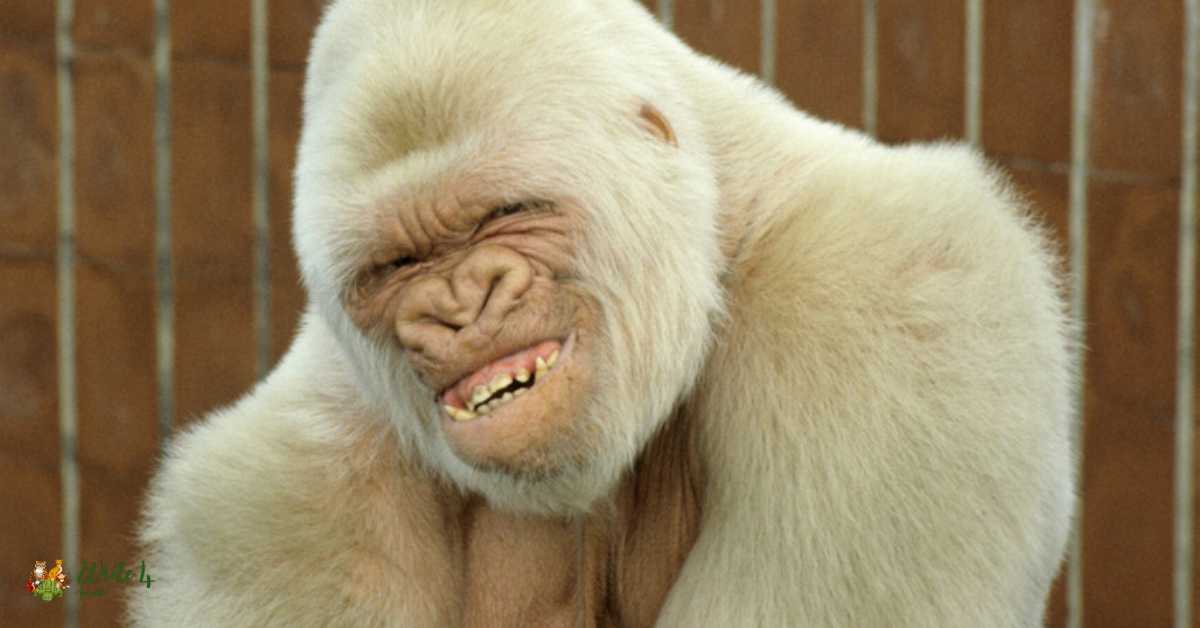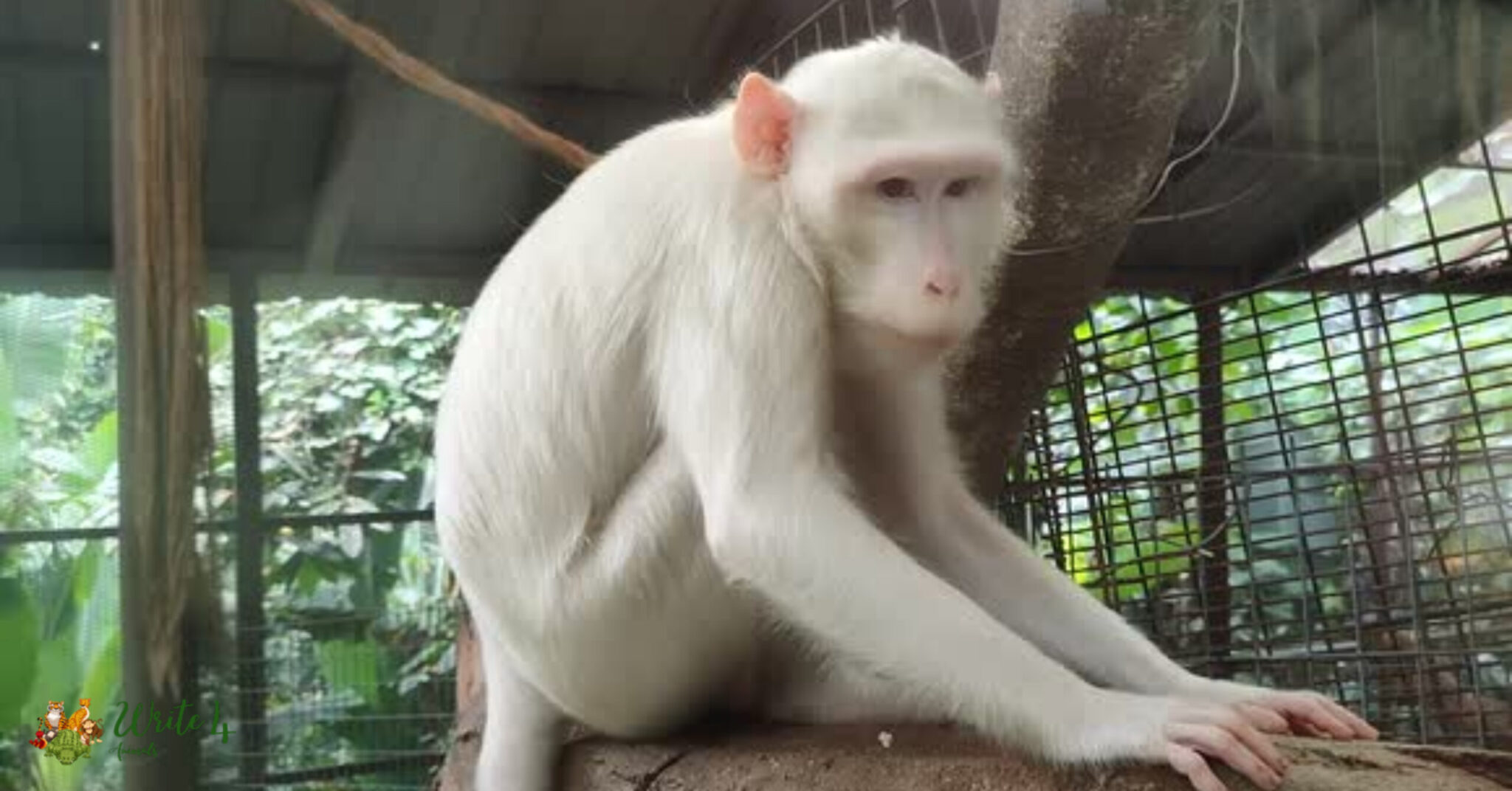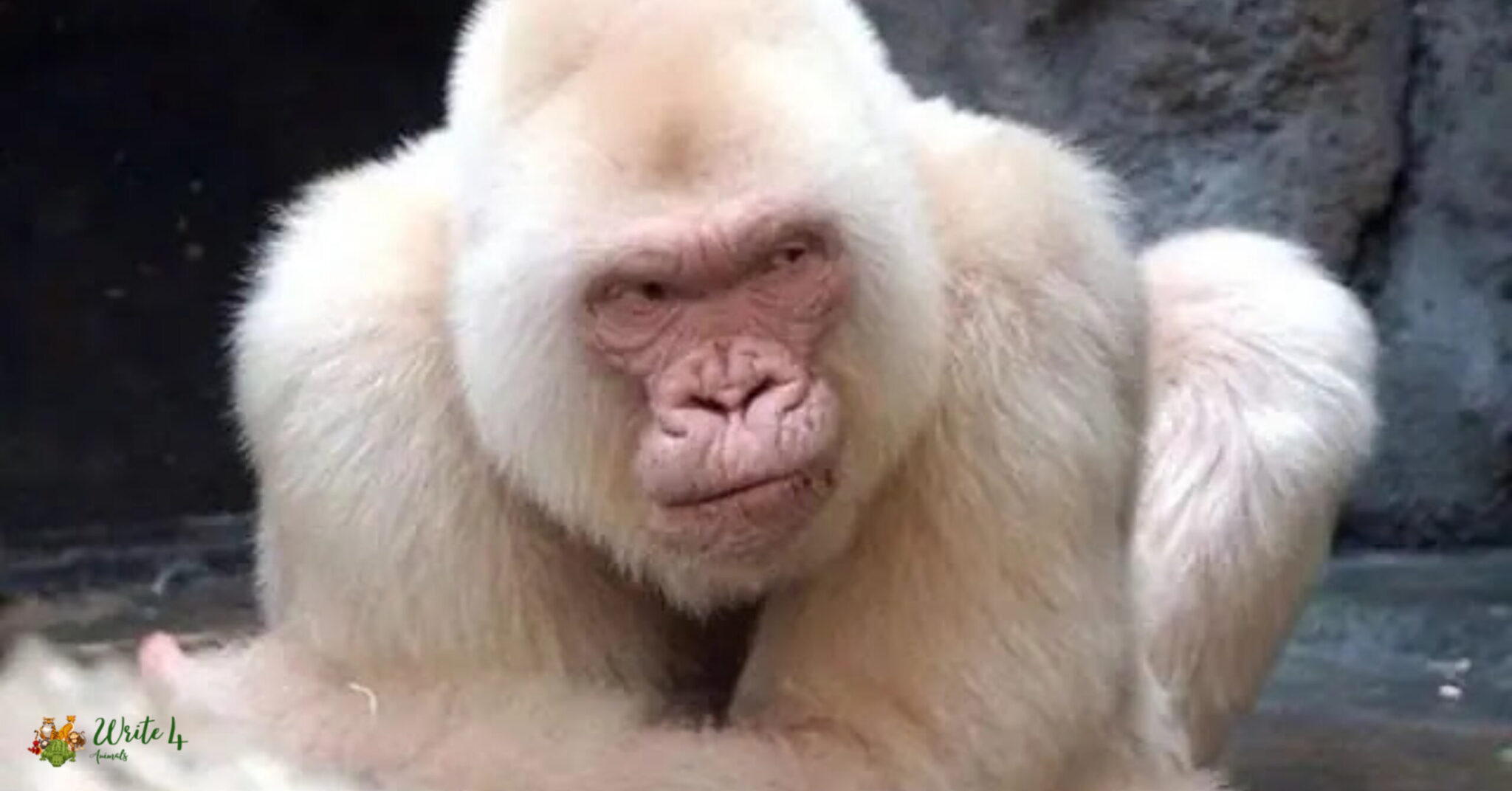In the heart of the lush rainforests and towering canopies, a rare and captivating sight can occasionally be found—albino monkeys. These enchanting creatures stand out against the vibrant backdrop of the jungle with their striking white fur and mesmerizing pink or red eyes.
The phenomenon of albino monkeys is both intriguing and mysterious, offering a glimpse into the intricate tapestry of nature’s diversity.
In this blog post, we delve into the world of Albino monkey, exploring their uniqueness, challenges, and the conservation efforts dedicated to preserving their existence.
About Albino Monkeys
History of Albino Monkey
The history of albino monkeys traces back to the broader understanding of albinism in animals. Albinism is a genetic condition caused by the absence or deficiency of melanin, the pigment responsible for skin, hair, and eye color.
The occurrence of albino animals, including monkeys, has been documented for centuries, captivating human curiosity and interest.
Ancient civilizations often regarded these rare creatures with a mixture of awe and superstition, attributing mystical qualities to their unique appearance.
Appearance of Albino Monkey
Albino monkeys exhibit a captivating and distinct appearance that sets them apart from their non-albino counterparts. Their most striking feature is their lack of pigmentation, resulting in white or cream-colored fur and distinctive pink or red eyes due to the absence of melanin in the iris.

This remarkable combination of features can make them easily identifiable amidst the lush greenery of their natural habitats. However, their stunning appearance also renders them more susceptible to harsh sunlight and potential predators due to their lack of camouflage.
Habitat of Albino Monkeys
Albino monkeys inhabit a range of habitats across different regions of the world, reflecting the diversity of primate species that can express albinism.
These habitats include tropical rainforests, dense woodlands, and even urban areas. Long-tailed macaques with albinism, for example, may be found in the forests of Southeast Asia, while albino vervet monkeys can be observed in African rainforests.
Their habitats typically provide the necessary resources for survival, such as food sources, water, and suitable shelter. It’s worth noting that albino monkeys may face distinct challenges due to their lack of camouflage, making them more susceptible to predation or human disturbances.
Lifespan of Albino Monkey
The albino monkeys lifespan is generally similar to that of their non-albino counterparts. Depending on the species, environmental conditions, and potential threats, albino monkeys can live anywhere from 15 to 30 years or more in the wild.
Factors such as access to food, availability of resources, and protection from predators play a significant role in determining their lifespan.
In captivity, where they receive proper care, their lifespan can sometimes exceed that of wild individuals due to reduced exposure to natural risks.
Nature of Albino Monkey
Albino monkeys share behavioral traits with their non-albino counterparts specific to their species. They engage in social interactions, forage for food, and exhibit natural behaviors that are characteristic of their primate family.
Their unique appearance might influence their interactions with other monkeys, potentially impacting their role within their social groups.
Albino monkeys’ behavior can also be influenced by their sensitivity to sunlight and their reduced ability to blend into their environment. Their responses to these challenges may differ from those of their normally pigmented counterparts.
Diet of Albino Monkey
The diet of albino monkeys varies depending on the species and their specific habitat. Just like other primates, they are typically omnivorous, consuming a mix of fruits, leaves, insects, and occasionally small animals.
For instance, albino long-tailed macaques might feed on fruits, seeds, and plant material, while albino vervet monkeys might include insects and young leaves in their diet.
Their dietary preferences are closely linked to the availability of resources in their environment, and their foraging behaviors are influenced by their natural instincts.
Predators of Albino Monkey
Albino monkeys face similar predators as their non-albino counterparts, but their lack of camouflage can make them more susceptible to predation. Natural predators can include large birds of prey, big cats like leopards and jaguars, and other carnivorous mammals.
Additionally, human activities such as deforestation and habitat fragmentation can expose them to more human-made threats.
Conservation efforts play a crucial role in protecting albino monkeys and their habitats from these potential dangers, as preserving their ecosystems is essential for their survival in the wild.
Types of Albino Monkeys
Albino monkeys, characterized by a lack of melanin pigment in their skin, fur, and eyes, can belong to various species. Albino individuals within a species exhibit a distinctive white or light-colored appearance. Here are a few examples of albino monkeys.

1. Albino Capuchin Monkey: Capuchin monkeys, known for their intelligence and dexterous hands, can occasionally exhibit albino traits. Albino capuchins lack the typical pigmentation seen in their species, resulting in a pale or white fur coat.
2. Albino Howler Monkey: Howler monkeys, recognized for their vocalizations, can also display albino characteristics. The albino howler monkey would stand out in the canopy due to its light-colored fur, making it more vulnerable to predators.
3. Albino Squirrel Monkey: Squirrel monkeys, with their small size and distinctive facial markings, may have albino individuals within their populations. Albino squirrel monkeys would have a unique, pale appearance compared to their normally colored counterparts.
4. Albino Spider Monkey: Known for their long limbs and prehensile tails, spider monkeys may rarely exhibit albinism. Albino spider monkeys would lack the usual dark pigmentation in their fur and facial features.
Albino Monkeys Facts
Albino monkeys, with their rare and captivating appearance, are the subject of fascination and intrigue. Here are some intriguing facts that shed light on these unique creatures:
Genetic Anomaly: Albino monkeys result from a genetic anomaly that inhibits the production of melanin, the pigment responsible for skin, hair, and eye color. This absence of pigment gives them their characteristic white fur and pink or red eyes.
Susceptibility: Due to their lack of protective melanin, albino monkeys are more vulnerable to harsh sunlight and UV radiation. This makes them prone to sunburn and eye sensitivity, necessitating protective measures.
Social Interaction: Albino monkeys, like their non-albino counterparts, engage in complex social behaviors within their respective species. Their unique appearance may impact their interactions within their social groups, offering insights into how physical traits influence social dynamics.
Human Connection: In some regions, albino monkeys have formed unique connections with humans, such as the sacred status of long-tailed macaques in Balinese culture. These interactions highlight the cultural significance of these animals.
Conservation Concerns: The striking appearance of albino monkeys can attract both positive and negative attention. While they are captivating to observe, they are also susceptible to predation due to their lack of camouflage.
Conservation of Albino Monkeys
Albino monkeys, with their rare and captivating appearance, hold a special place in the realm of wildlife conservation. Their distinctiveness calls for dedicated efforts to ensure their survival and well-being. Here’s an insight into the conservation initiatives aimed at safeguarding these remarkable creatures:
1. Habitat Protection:
Preserving the natural habitats of albino monkeys is crucial to their survival. Deforestation and habitat fragmentation are major threats, disrupting their ecosystems and reducing available resources. Conservation organizations work to establish protected areas, enforce anti-deforestation measures, and promote sustainable land use to maintain the habitats these primates call home.
2. Research and Monitoring:
Comprehensive research on albino monkeys’ behaviors, genetics, and adaptations contributes to effective conservation strategies. Monitoring their populations provides valuable insights into their numbers, distribution, and potential threats, enabling conservationists to make informed decisions.
3. Education and Awareness:
Raising awareness about the significance of albino monkeys is essential. Educational programs and campaigns inform local communities and the public about the importance of preserving these unique creatures. Communities play a vital role in habitat protection and can benefit from sustainable ecotourism initiatives that generate income without harming the environment.
4. Anti-Poaching Efforts:
Albino monkeys, due to their distinct appearance, might attract illegal wildlife trade. Conservation organizations collaborate with law enforcement agencies to combat poaching and trafficking. By curbing these activities, they ensure that albino monkeys remain safe from exploitation.
5. Veterinary Care and Rehabilitation:
In cases where albino monkeys are injured, orphaned, or in need of care, rehabilitation centers provide vital support. Veterinarians and caregivers offer medical attention, nourishment, and a safe environment for their recovery before their eventual return to the wild.
6. Genetic Diversity Preservation:
Albino monkeys represent unique genetic variations within their species. Protecting their populations contributes to the overall genetic diversity of primate populations, which is vital for the long-term health and resilience of these species.
7. Community Engagement:
Engaging with local communities is integral to successful conservation efforts. Collaborative initiatives that involve communities in habitat management, research, and eco-friendly practices foster a sense of ownership and responsibility for the environment and its inhabitants.
Video Credit – Wakaleo
what is a albino monkey worth
Generally, albino animals are considered rare and may fetch higher prices in the exotic pet market compared to their non-albino counterparts. However, it’s important to note that keeping primates as pets is a controversial topic due to their complex care needs, potential for aggression, and the ethical concerns surrounding their captivity.
Frequently Asked Questions
[sc_fs_multi_faq headline-0=”h4″ question-0=”What is an albino monkey?” answer-0=”An albino monkey is an individual that exhibits albinism, a genetic condition characterized by the absence of melanin, the pigment responsible for skin, hair, and eye color. Albino monkeys have white or cream-colored fur and pink or red eyes due to the lack of melanin.” image-0=”” headline-1=”h4″ question-1=”Where can albino monkeys be found?” answer-1=”Albino monkeys have been documented in various primate species across different regions of the world. Long-tailed macaques with albinism can be found in Southeast Asia, while albino vervet monkeys have been observed in African rainforests.” image-1=”” headline-2=”h4″ question-2=”Are albino monkeys rare?” answer-2=”Yes, albino monkeys are rare. The occurrence of albinism in any species, including primates, is relatively uncommon due to the genetic mutations required for the condition to manifest.” image-2=”” headline-3=”h4″ question-3=”What is the difference between albinism and leucism?” answer-3=”Albinism is the absence of all pigmentation, resulting in white fur and pink or red eyes. Leucism, on the other hand, is a partial lack of pigmentation, leading to lighter patches on the skin, fur, or feathers while retaining some pigmented areas.” image-3=”” headline-4=”h4″ question-4=”How do albino monkeys survive in the wild?” answer-4=”Albino monkeys face challenges due to their lack of camouflage and increased sensitivity to sunlight. They rely on their natural instincts, social behaviors, and access to resources such as food and shelter to survive. Conservation efforts play a vital role in protecting their habitats and well-being.” image-4=”” headline-5=”h4″ question-5=”What is the lifespan of albino monkeys?” answer-5=”The lifespan of albino monkeys varies depending on factors such as species, environment, and threats. Generally, they can live anywhere from 15 to 30 years or more in the wild. Proper care in captivity can sometimes extend their lifespan.” image-5=”” headline-6=”h4″ question-6=”How do albino monkeys adapt to their environment?” answer-6=”Albino monkeys may have unique adaptations to cope with their environment, such as behavioral modifications. However, their lack of pigmentation can impact their ability to blend in, potentially making them more susceptible to predation.” image-6=”” headline-7=”h4″ question-7=”What is the diet of albino monkeys?” answer-7=”The diet of albino monkeys varies depending on the species and their specific habitat. Just like other primates, they are typically omnivorous, consuming a mix of fruits, leaves, insects, and occasionally small animals. Their dietary preferences are closely linked to the availability of resources in their environment.” image-7=”” headline-8=”h4″ question-8=”Who are the predators of albino monkeys?” answer-8=”Albino monkeys face similar predators as their non-albino counterparts, including large birds of prey, big cats, and carnivorous mammals. Their lack of camouflage due to albinism can increase their vulnerability to predation.” image-8=”” headline-9=”h4″ question-9=”How can we contribute to albino monkey conservation?” answer-9=”Supporting organizations dedicated to primate conservation, raising awareness about the challenges faced by albino monkeys, and advocating for habitat protection are some ways to contribute to their conservation.” image-9=”” count=”9″ html=”true” css_class=””]
Recommended
1. 20 Taiga animals | Boreal forest animals
2. Snickerdoodle Dog: Everything you need to know
